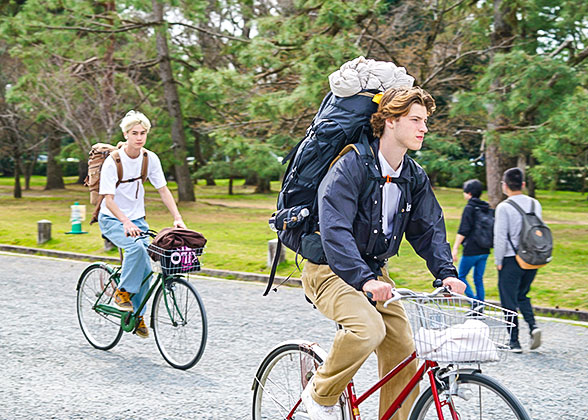Cycling in Japan
It’s a wonderful idea for cycling lovers and outdoor enthusiasts, to discover the beautiful sceneries that few other tourists could see. The crisscrossed transportation network and facilities provide convenience for cycling.The Best Time to Go Cycling in Japan

|
As it is torrid in most places in summer, it’s the best to go cycling during the hottest months (usually June to August) in the cooler Hokkaido and northern Honshu, while avoiding the chilly winter in the region. If you want to admire tropical island scenery, you can enjoy cycling around Okinawa islands all year around.
Anyway, watch the local weather on your cycling tour in Japan, and avoid cycling on typhoon days.
Read more about Best Time to Visit Japan
Popular Routes & Best Regions for Cycling
What should be packed up/prepared for your cycling in Japan?
• A couple of waterproof pants, alternate tops and sturdy shoes are definitely the necessities. A fully equipped first-aid kit and a portable charger are also essential for a long cycling trip.• You should prepare a good-quality lock just in case, even though it is unlikely that your bike will be stolen in Japan.
• The sun is very strong in summer, so be sure to hydrate yourself and wear sunglasses.
• Wear a safety helmet anyway when cycling.
• You can get the map on your smart phone, or get a paper map beforehand. This is to prevent getting lost and to facilitate asking for directions.

Cyclists at Port of Kobe
|
How to Transport Your Bicycle to Japan
To transport your bicycle to Japan, you should take it apart and pack the assembly parts into the proper loading box. Then, consign the bicycle via airlines when you fly to Japan. Please consult the airlines for air consignment of bicycle just in case, before booking an air ticket.If you need to transport your bicycle in Japan by trains, subway, etc., you must pack the parts in the specialized bag. You can find such a bag in any road bicycle shop around the country.
Where to Hire a Bicycle in Japan
If you just want to have a short cycling, many ryokans, hotels and shops offer bicycle rental service. Some bicycle rentals are distributed by the local railway station, which is easy to be found. It is also easy to register with your passport or driving license, with a cheap fare and no guarantee deposit. In some places for daily rental, you can only take your credential back when returning the bicycle before the specific time, usually in the evening. It would be better to learn and confirm their rules before renting.In the big cities like Tokyo, Yokohama and Osaka, bicycle sharing is also popular.
Traffic Rules of Cycling in Japan
• In Japan, ride on the left side of the road/lane, in the belt/dedicated roads for pedestrians and cyclists.
• Obey the signal lights when riding. Learn the signs and signal lights in Japan before your cycling tour.
• Unexpectedly, bicycles must be equipped with reliable lights and reflectors front and back. Turn on the lights for night riding.
• Two cyclists can’t ride in parallel; one bicycle is only for one person, it’s forbidden to carry another person on the backseat.
• No phone calls, no wearing headphones, and no riding with one hand.
• No drink riding! Yes, not even a bicycle.
• Don’t ring the bicycle bell frequently when cycling in Japan, even you need to remind the pedestrians or cyclists aside.
• In the site where there is a "stop" sign (red inverted triangle) or marked "stop", please stop at the stop line, carefully confirm the safety of both the left and right sides, and then ride through the place.

Cycling around Lake Kawaguchi
|
Where to Park a Bicycle
There are usually designated areas for bicycle parking in Japan, mostly in front of the railway or bus stations. A bicycle parked in non-designated areas may be confiscated and a fine must be paid to get it back. In large cities, there are usually bicycle parking areas, but some are limited to bikes that have been registered with monthly parking fee. Thus, you can confirm with your ryokan, hotel or bike rental shop ahead of time, to find out where you can park.Tips for Cycling in Japan
• Since Japan is more mountainous, it is recommended to switch the bike to a low gear to reduce the burden on the body.• Never pick an ownerless bicycle up at the roadside, for such a behavior would be considered as theft. The person would be sentenced to two or three years or even deportation in severe case.
• Check your bicycle and keep it to the best state, including maintenance, replacement of chain tires, etc. Relatively, you can find a local service to repair the vehicle, but it’s impossible in remote areas.
• It is a great joy of the bicycle tour to stop for eating. You can stop at local restaurants to taste the authentic food, or buy affordable and delicious ready-to-eat snacks at convenience stores that can be found in almost every town.
• Overnight options include ryokans, guesthouses, homestays, and even tents under the stars. However, please make a reservation in advance, especially in the peak seasons.
You May Like: How to Travel around Japan: What’s the Best Way

